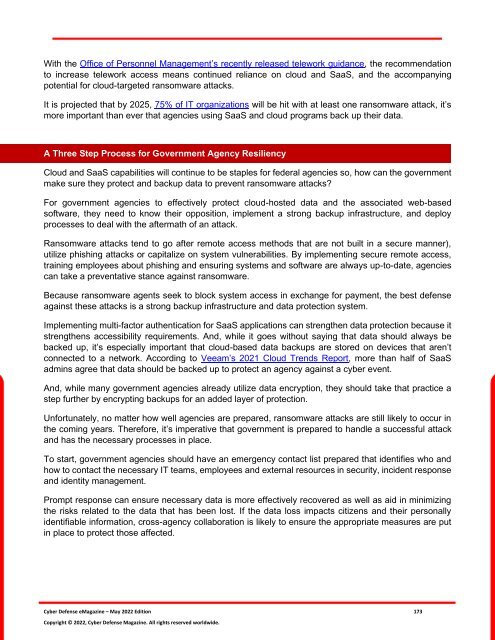Cyber Defense eMagazine May Edition for 2022
Cyber Defense eMagazine May Edition for 2022 #CDM #CYBERDEFENSEMAG @CyberDefenseMag by @Miliefsky a world-renowned cyber security expert and the Publisher of Cyber Defense Magazine as part of the Cyber Defense Media Group as well as Yan Ross, Editor-in-Chief and many more writers, partners and supporters who make this an awesome publication! Thank you all and to our readers! OSINT ROCKS! #CDM #CDMG #OSINT #CYBERSECURITY #INFOSEC #BEST #PRACTICES #TIPS #TECHNIQUES
Cyber Defense eMagazine May Edition for 2022 #CDM #CYBERDEFENSEMAG @CyberDefenseMag by @Miliefsky a world-renowned cyber security expert and the Publisher of Cyber Defense Magazine as part of the Cyber Defense Media Group as well as Yan Ross, Editor-in-Chief and many more writers, partners and supporters who make this an awesome publication! Thank you all and to our readers! OSINT ROCKS! #CDM #CDMG #OSINT #CYBERSECURITY #INFOSEC #BEST #PRACTICES #TIPS #TECHNIQUES
- No tags were found...
Create successful ePaper yourself
Turn your PDF publications into a flip-book with our unique Google optimized e-Paper software.
With the Office of Personnel Management’s recently released telework guidance, the recommendation<br />
to increase telework access means continued reliance on cloud and SaaS, and the accompanying<br />
potential <strong>for</strong> cloud-targeted ransomware attacks.<br />
It is projected that by 2025, 75% of IT organizations will be hit with at least one ransomware attack, it’s<br />
more important than ever that agencies using SaaS and cloud programs back up their data.<br />
A Three Step Process <strong>for</strong> Government Agency Resiliency<br />
Cloud and SaaS capabilities will continue to be staples <strong>for</strong> federal agencies so, how can the government<br />
make sure they protect and backup data to prevent ransomware attacks?<br />
For government agencies to effectively protect cloud-hosted data and the associated web-based<br />
software, they need to know their opposition, implement a strong backup infrastructure, and deploy<br />
processes to deal with the aftermath of an attack.<br />
Ransomware attacks tend to go after remote access methods that are not built in a secure manner),<br />
utilize phishing attacks or capitalize on system vulnerabilities. By implementing secure remote access,<br />
training employees about phishing and ensuring systems and software are always up-to-date, agencies<br />
can take a preventative stance against ransomware.<br />
Because ransomware agents seek to block system access in exchange <strong>for</strong> payment, the best defense<br />
against these attacks is a strong backup infrastructure and data protection system.<br />
Implementing multi-factor authentication <strong>for</strong> SaaS applications can strengthen data protection because it<br />
strengthens accessibility requirements. And, while it goes without saying that data should always be<br />
backed up, it’s especially important that cloud-based data backups are stored on devices that aren’t<br />
connected to a network. According to Veeam’s 2021 Cloud Trends Report, more than half of SaaS<br />
admins agree that data should be backed up to protect an agency against a cyber event.<br />
And, while many government agencies already utilize data encryption, they should take that practice a<br />
step further by encrypting backups <strong>for</strong> an added layer of protection.<br />
Un<strong>for</strong>tunately, no matter how well agencies are prepared, ransomware attacks are still likely to occur in<br />
the coming years. There<strong>for</strong>e, it’s imperative that government is prepared to handle a successful attack<br />
and has the necessary processes in place.<br />
To start, government agencies should have an emergency contact list prepared that identifies who and<br />
how to contact the necessary IT teams, employees and external resources in security, incident response<br />
and identity management.<br />
Prompt response can ensure necessary data is more effectively recovered as well as aid in minimizing<br />
the risks related to the data that has been lost. If the data loss impacts citizens and their personally<br />
identifiable in<strong>for</strong>mation, cross-agency collaboration is likely to ensure the appropriate measures are put<br />
in place to protect those affected.<br />
<strong>Cyber</strong> <strong>Defense</strong> <strong>eMagazine</strong> – <strong>May</strong> <strong>2022</strong> <strong>Edition</strong> 173<br />
Copyright © <strong>2022</strong>, <strong>Cyber</strong> <strong>Defense</strong> Magazine. All rights reserved worldwide.


















